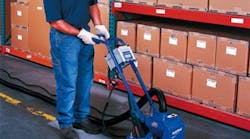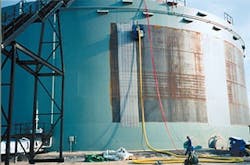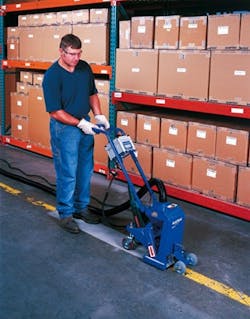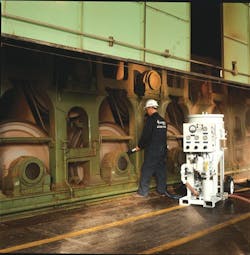Every plant has components that require painting or coating. Most plants outsource a significant portion of the blast and paint work to industrial coating contractors because they have the equipment and the expertise to perform the work safely and efficiently.
Coating contractors and in-house maintenance departments have a range of surface preparation equipment from which to chose. Methods include abrasive airblasting or sandblasting, blast and recovery (vacuum) systems, recycling wheelblast systems and ultrahigh pressure waterjetting.
Abrasive airblasting or sandblasting
Abrasive airblasting is an established technique for cleaning and profiling metal and concrete surfaces. It removes coatings, mill scale, rust, grease, oil and contaminants. Abrasive airblasting systems are popular because they're suitable for a range of substrates, offer fast removal rates, are relatively inexpensive and simple to operate without extensive training. Their high degree of portability adds to their flexibility and appeal. An airblasting operation involves:
A portable blaster.
Moisture separator to ensure unimpeded abrasive flow.
A metering and control system for the abrasive.
Blasting nozzle.
Hose.
Air compressor.
Personal protection equipment.
Abrasive media is held in a pressurized blast pot or blaster. Compressed air propels the abrasive through a hose and nozzle toward the surface being treated. Blast media ranges from soft (baking soda, walnut shell or corn cob) to medium (glass bead) to hard (steel, aluminum oxide or metal slag).
Abrasive media selection depends on coating type and thickness, substrate, the desired profile and the production rate. These factors determine the shape and hardness of the desired abrasive media. Metal abrasives are more aggressive, while non-metallic abrasives, such as plastic, walnut shell and sodium bicarbonate, are used for surface cleaning, not profile modification. Blunt media, such as glass beads, can provide a peening effect.
Also consider environmental regulations. For safety reasons, abrasives containing free silica (such as sand) should not be used for abrasive airblasting. Abrasive airblasting is most applicable for small areas, irregular shapes or areas with obstructions, such as pipes, vessels and pipe racks.
Abrasive airblasting is familiar and used widely. It handles a wide range of abrasive types and achieves rapid removal rates. On the other hand, it requires containment because of environmental and safety concerns. Other workers must not be in the area when blasting occurs. The media is not recycled automatically, so abrasive cost can be an issue and disposal costs can be high, especially for contaminants such as lead paint.
Blast and recovery (vacuum) systems
When traditional, open airblasting is not possible or practical, blast and recovery systems are the best alternative. Applications include removing lead paint and asbestos, blasting indoors and touch-up blasting in combination with other blast and recovery methods. As with traditional airblasting, compressed air propels abrasive from a pressurized blast vessel through a hose and nozzle.
If the system is to blast and recover at the same time, abrasive first travels from the vessel through a valve that controls the release of media into the air stream. After blasting, a vacuum system recovers media through the blast head and passes it through a cyclone separator, where media and large particles drop to the bottom. Everything else goes to a dust collector that uses wet filtration, dry filtration or HEPA filtration. Media recovered from the cyclone passes through a screen and is reloaded into the now depressurized vessel.
Blast and recovery systems are most applicable for small areas, indoor blasting, removing hazardous materials (lead paint, asbestos) and working around sensitive equipment, such as switchgear and electronic equipment. Its advantages include recycled abrasive as well as simplified waste containment and disposal. It allows other trades to work simultaneously and it's environmentally friendly. However, it's a slow method that requires very dry compressed air. Also, the blast workhead obscures the operator's view of the work surface.
Recycling wheelblast
These systems use a high-performance wheel that hurls blast media at the surface in a controlled pattern and direction. Wheel-thrown metal abrasive scours concrete or steel surfaces and rebounds, along with contaminants, dust and debris, into a recovery chamber. Dust and contaminants move to a dust collector and blast media is returned to the storage hopper for reuse.
Horizontal wheelblast systems are used on concrete surfaces, such as floors, or steel surfaces such as storage tank floors and roofs. Vertical wheelblast systems, operated in conjunction with roof rigging systems, a winch or crane, can service storage tanks and other vertical or near-vertical steel surfaces (see Figure 1). Vertical systems are operated via remote control.
Figure 1. Recycling wheelblast systems are particularly applicable for large steel surfaces such as this storage tank. Photo courtesy of Blastrac.
Recycling wheelblast systems are most applicable for concrete surface coating preparation and large steel surface blasting (see Figure 2). Its advantages include:
No need for containment.
Simplified waste disposal.
Cost savings from recycled abrasive.
High production rates.
Allowing other trades to work simultaneously.
Being environmentally friendly.
Reduced operator fatigue, greater operator safety.
Figure 2. Plant warehouse floors can be prepared for restriping or recoating with recycling wheelblast (shot blast) systems. Photo courtesy of Blastrac.
System use is limited to flat surfaces and equipment cost is high compared to abrasive airblasting. Also, vertical systems are not suitable for non-vertical or irregular surfaces.
Ultrahigh pressure waterjetting
Ultrahigh pressure waterjetting systems operate with water that's been pressurized to between 10,000 psi and 40,000 psi for preparing concrete and steel surfaces. A separate unit filters contaminants from the water. Ultrahigh pressure waterjetting systems are available as hand-held tools (wands and lances), semi-automatic systems and robotic, remote-controlled systems. They're available for both horizontal and vertical surfaces.
Ultrahigh pressure waterjetting systems are most applicable for a range of applications, including large vertical or horizontal surfaces and irregular surfaces. There is no need for containment with robotic systems. Waste disposal is simplified with filtered water systems. Other trades can work simultaneously (robotic system).
These systems don't produce a surface profile and can produce flash rusting. Wand and lance systems require containment. Initial purchase price and maintenance costs are high.
Soda blasting
In addition to traditional maintenance painting, some plants have special maintenance requirements for production equipment. These applications use abrasive airblast systems designed specifically to use sodium bicarbonate (baking soda) media. These systems take advantage of baking soda's non-toxic, environmentally benign cleaning, degreasing and deodorizing abilities. Baking soda is safe for use on any surface found in the plantbrick, limestone, concrete, granite, metal, glass and tile. Common uses for these systems include graffiti removal, architectural cleaning, industrial cleaning, degreasing, general maintenance and more.
In food processing facilities, soda blasting systems clean production line equipment and floors. They degrease venting systems. Baking soda's food grade nature allows simple cleanup: everything rinses down the drain.
In the pulp and paper industry, soda blasting removes wood pulp residues and creosol from equipment and the rinse water and baking soda media go into the plant wastewater stream because baking soda doesn't harm the bacteria there (see Figure 3). Other popular uses for soda blasting include cleaning manufacturing molds of chemical release agents and contaminants, and anilox roll cleaning in the printing industry.
Figure 3. Blasting systems that use baking soda are available to meet specialized plant maintenance requirements. This photo is in a pulp and paper factory. Photo courtesy of Schmidt.
Soda blasting is most applicable for cleaning in sensitive environments and delicate substrates, degreasing and general cleaning, deodorizing and removing soot and smoke damage. Its advantages include a non-toxic, non-hazardous and non-sparking media that's safe for a range of substrates.
Soda blasting isn't well suited for difficult or challenging coating removal. It can't be recycled and must be rinsed from the substrate with clean water.
What to consider
Facility managers have a number of surface preparation options available for plant maintenance. Factors to consider when preparing a job specification for outside contractors, contemplating an equipment purchase or merely selecting a surface preparation method begin with environmental concerns. Some blast methods, such as recycling wheelblast, robotic ultrahigh pressure water and blast-and-recovery systems are more environmentally friendly.
Next, match the method to the structures to be blasted. A mix of methods may work best to handle plant requirements. Then, consider the type of coating(s) to be removed. One method may be favored, particularly if lead paint is involved. Finally, consider cost. Systems that require extensive containment, systems with high equipment cost, and systems that don't recycle abrasive can lead to higher costs for the contractor and, in turn, for you.
Allen Slater is a Regional Manager for Blastrac, part of the USF Surface Preparation Group. He can be reached at slatera@usfspg.com.



